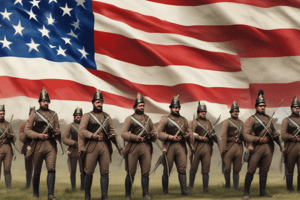Podcast
Questions and Answers
How many total states were in the Confederacy?
How many total states were in the Confederacy?
Eleven.
What were the advantages the North and the South had in the Civil War?
What were the advantages the North and the South had in the Civil War?
The North had a larger population and more resources. The South knew the territory well and had excellent military leaders.
What was the initial Union goal of the Civil War?
What was the initial Union goal of the Civil War?
To preserve the Union and have the Confederacy surrender.
What was the initial Confederate goal of the Civil War?
What was the initial Confederate goal of the Civil War?
What was the Confederate Capital?
What was the Confederate Capital?
What were the Southern strategies in the Civil War?
What were the Southern strategies in the Civil War?
What were the Northern strategies of the Civil War?
What were the Northern strategies of the Civil War?
What was the significance of the First Battle of Bull Run?
What was the significance of the First Battle of Bull Run?
What happened at the Battle of Antietam?
What happened at the Battle of Antietam?
What was the Emancipation Proclamation?
What was the Emancipation Proclamation?
What were the two reasons why Lincoln believed changing the focus of the war to ending slavery would benefit the Union?
What were the two reasons why Lincoln believed changing the focus of the war to ending slavery would benefit the Union?
What were the effects of the war on Southern families versus Northern families?
What were the effects of the war on Southern families versus Northern families?
What two parties did the Northern Democratic Party split into during the times of the Civil War?
What two parties did the Northern Democratic Party split into during the times of the Civil War?
What was the significance of the Battle of Gettysburg?
What was the significance of the Battle of Gettysburg?
What was the significance of the Battle of Vicksburg?
What was the significance of the Battle of Vicksburg?
Which General led the U.S. forces in the final battles of the Civil War?
Which General led the U.S. forces in the final battles of the Civil War?
Who won the 1864 election and how did this affect the outcome of the war?
Who won the 1864 election and how did this affect the outcome of the war?
Flashcards are hidden until you start studying
Study Notes
Confederacy and Overall Civil War Context
- Eleven states comprised the Confederacy.
- Initial Union goal was to preserve the Union and compel Confederacy to surrender.
- Confederate aim was to gain independence and demonstrate the war's high costs to the Union.
Military Strategies and Advantages
- North had a larger population and more resources; South had tactical home-ground advantage and strong military leaders.
- Southern strategies involved a defensive approach and seeking support from Britain and France due to economic ties to Southern cotton.
- Northern strategies included the Anaconda Plan, which aimed to blockade Southern ports and control the Mississippi River to split the Confederacy.
Key Battles and Turning Points
- First Battle of Bull Run (1861): Confederate victory led to Northern realization of war's intensity.
- Battle of Antietam (1862): Marked major Union victory; General Lee suffered significant losses after his invasion of Maryland.
- Battle of Gettysburg: Turning point for the Union; it followed multiple Confederate successes and significantly raised Union morale.
- Battle of Vicksburg: Key Union victory that captured a strategic river city, effectively dividing the Confederacy.
Emancipation Proclamation and Its Impact
- Issued by Abraham Lincoln on January 1, 1863, it declared freedom for all enslaved people in rebel territory, shifting the war's focus to ending slavery.
- Lincoln believed this focus would reduce European support for the Confederacy and address the root causes of the conflict.
Social and Political Effects
- Southern families faced devastation and displacement, with significant shortages of goods; Northern families experienced less disruption and even benefitted economically from wartime demands.
- The Northern Democratic party fractured into War Democrats and Peace Democrats amid wartime debates.
Final Phases and Leadership
- General Ulysses Grant led U.S. forces during the final battles, determined to press for surrender.
- Lincoln's re-election in 1864 was pivotal, bolstering Northern resolve to achieve victory in the war.
Studying That Suits You
Use AI to generate personalized quizzes and flashcards to suit your learning preferences.




